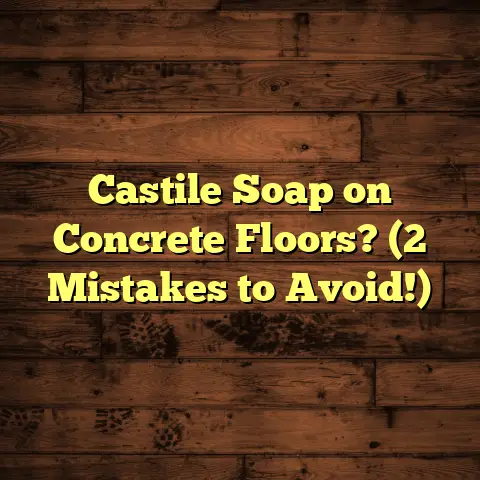Reclaimed Wood Flooring Cost Per Square Foot (Explained)
As flooring options, reclaimed wood stands out as a popular choice due to its unique character and sustainability. However, understanding the costs associated with installing reclaimed wood flooring is crucial for homeowners and business owners alike. This article will provide a comprehensive overview of the cost factors involved, detailed price breakdowns, comparisons with alternative flooring options, and insights into maintenance and installation.
Understanding Cost Factors
Before diving into specific costs, it’s essential to identify the major factors that influence the price of reclaimed wood flooring installations:
1. Area Size
The total square footage of the area where the flooring will be installed directly impacts the overall cost. Larger areas typically benefit from economies of scale but may also require more significant upfront investment.
2. Hardwood Type
Reclaimed wood can be sourced from various types of trees, such as oak, pine, maple, and walnut. Each type has its own cost range based on availability, rarity, and durability.
3. Labor Costs
Labor costs can vary significantly based on location, the complexity of the installation, and the contractor’s experience. Professional installation often includes preparation work, which can add to the cost.
4. Additional Considerations
Other factors that may affect pricing include:
- Floor Removal: If existing flooring must be removed, this will incur additional costs.
- Subfloor Replacement: A damaged subfloor may need replacement, further increasing expenses.
- Material Grade: Higher-grade materials are typically more expensive but offer better aesthetics and durability.
- Room Size/Layout: Unusual room shapes or layouts can complicate installation and increase costs.
- Installation Type: The method of installation (nail-down, glue-down, floating) can affect both labor and material costs.
Cost Breakdown and Price Ranges
Average Cost Per Square Foot
The average cost for reclaimed wood flooring ranges from $5 to $15 per square foot. Here’s a breakdown based on wood types:
- Pine: $5 – $10 per square foot
- Oak: $8 – $12 per square foot
- Maple: $9 – $14 per square foot
- Walnut: $10 – $15 per square foot
Example Cost Estimates by Project Size
| Project Size (sq. ft.) | Estimated Cost (Low) | Estimated Cost (High) |
|---|---|---|
| 100 | $500 | $1,500 |
| 500 | $2,500 | $7,500 |
| 1,000 | $5,000 | $15,000 |
These estimates include both materials and labor but may vary based on local market conditions.
Comparing Hardwood with Alternative Flooring Options
When considering flooring choices, it’s essential to compare costs with alternatives such as laminate, vinyl, and carpet.
| Flooring Type | Average Cost Per Square Foot | Durability | Maintenance |
|---|---|---|---|
| Reclaimed Wood | $5 – $15 | High | Moderate |
| Laminate | $1 – $3 | Moderate | Low |
| Vinyl | $2 – $5 | High | Low |
| Carpet | $2 – $6 | Low | High |
While alternatives may have lower upfront costs, reclaimed wood offers unique aesthetic and environmental benefits that many homeowners find invaluable.
Signs That Hardwood Floors Need Replacement
Recognizing when your hardwood floors require replacement is vital in maintaining the integrity of your home. Here are some key signs:
- Severe Scratches or Gouges: If your floors have deep scratches that cannot be sanded out, it may be time for replacement.
- Warping or Cupping: Damage due to moisture can lead to warping or cupping of the boards.
- Persistent Odors: Lingering smells often indicate underlying problems such as mould or rot.
- Separation Between Boards: Gaps that appear between planks can signal that the wood is expanding or contracting excessively.
Refinishing vs. Replacement
Deciding whether to refinish or replace your hardwood floors depends on their condition:
- Refinish: If scratches are superficial and there’s minimal warping, refinishing can restore your floors to their former glory.
- Replace: If structural issues exist or if there’s extensive damage, replacement might be more cost-effective in the long run.
Pros and Cons of Hardwood Flooring
Pros
- Aesthetically Pleasing: Offers a timeless look that can enhance any space.
- Durability: With proper care, hardwood floors can last a lifetime.
- Increases Home Value: Quality hardwood flooring can raise property values.
Cons
- Cost: Higher initial investment compared to other flooring types.
- Maintenance: Requires regular upkeep to maintain appearance.
- Susceptible to Moisture: Can be damaged by water if not properly sealed.
Professional Installation vs. DIY
Choosing between professional installation and DIY can significantly impact your total project cost.
Professional Installation
Hiring professionals ensures proper installation but comes at a higher price. Costs for professional installation typically range from $3 to $8 per square foot. Benefits include:
- Expertise in handling complex installations.
- Access to specialized tools.
- Warranty on workmanship.
DIY Installation
While DIY can save money (potentially reducing total costs to $6 to $10 per square foot), it requires:
- Basic carpentry skills.
- Proper tools (e.g., saws, nail guns).
- Time and effort to learn installation methods.
Questions to Ask Hardwood Flooring Contractors
When selecting a contractor for your project, consider asking the following questions:
- What is your experience with reclaimed wood flooring?
- Can you provide references from previous clients?
- What is included in your estimate?
- How do you handle potential moisture issues?
- What warranties do you offer on materials and workmanship?
Hardwood Floor Care and Maintenance Tips
To maximise the longevity of your hardwood floors, follow these maintenance tips:
- Regular Cleaning: Sweep or vacuum regularly to remove dirt and debris. Use a damp mop with a wood-safe cleaner periodically.
- Humidity Control: Maintain indoor humidity levels between 30% and 50% to prevent expansion or contraction.
- Protect Against Scratches: Place felt pads under furniture legs and avoid wearing high heels indoors.
- Area Rugs: Use area rugs in high traffic zones to protect the finish.
- Refinishing Schedule: Plan for refinishing every 5 to 10 years based on wear and tear.
Conclusion
Investing in reclaimed wood flooring can bring beauty and sustainability to any space. Understanding the costs involved—ranging from material selection to installation—will help you make informed decisions for your project. Whether you choose to hire professionals or take on a DIY challenge, being equipped with knowledge about maintenance will ensure your floors remain stunning for years to come. With this guide in hand, you’re now ready to embark on your hardwood flooring journey!





